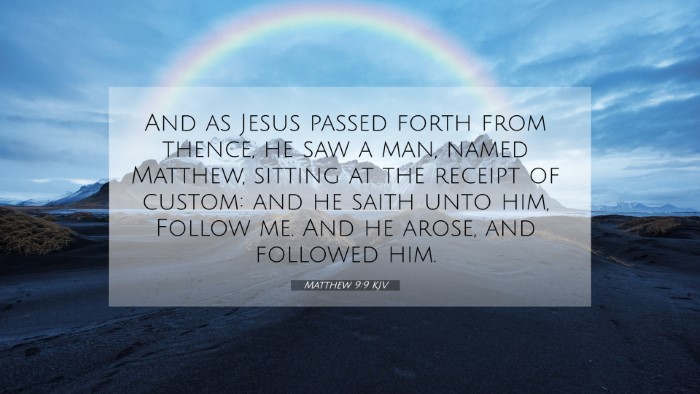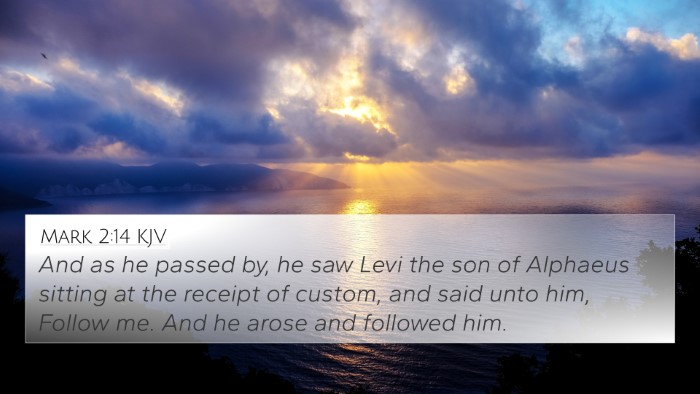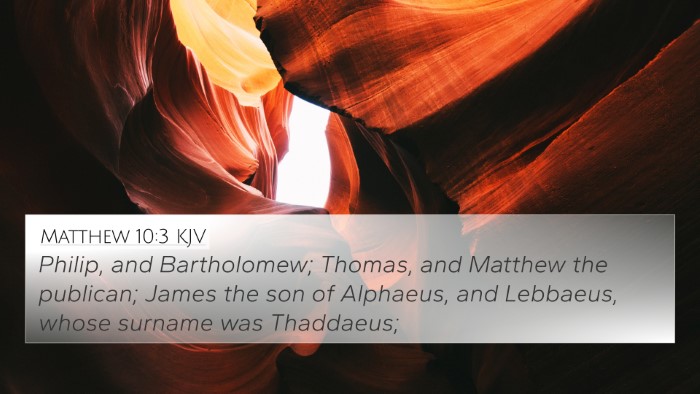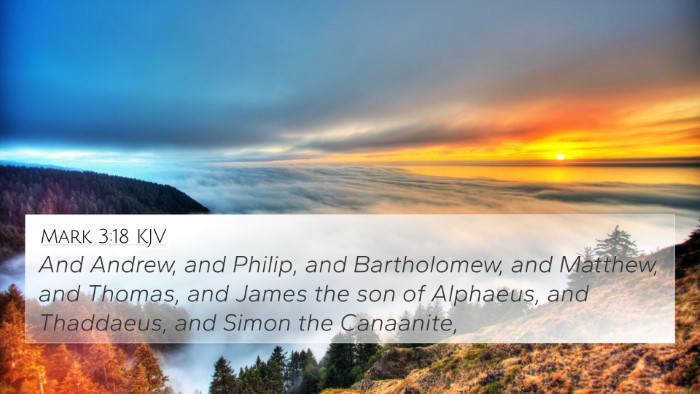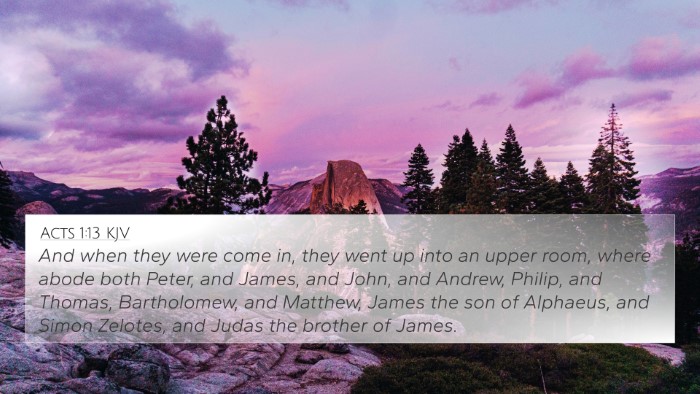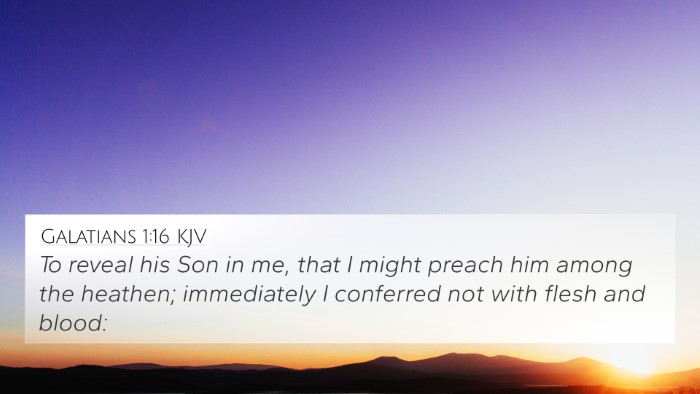Understanding Matthew 9:9
Matthew 9:9: "As Jesus went on from there, he saw a man named Matthew sitting at the tax collector's booth. 'Follow me,' he told him, and Matthew got up and followed him."
Summary of Insights
This verse signifies a pivotal moment in the Gospel of Matthew where Jesus calls Matthew, a tax collector, to discipleship. The following analysis draws from various public domain commentaries to offer a comprehensive interpretation.
Key Themes
- The Call to Discipleship: The immediate and unreserved response of Matthew illustrates the nature of Jesus' call and the urgent response required from His followers.
- Transformation: Matthew's transition from a tax collector, often viewed with disdain, to a disciple of Christ showcases the transformative power of Jesus' ministry.
- Inclusiveness of Christ: This event emphasizes Christ's mission to the marginalized and outcast in society, highlighting His desire to reach all people.
Bible Verse Cross-References
To fully grasp the implications of Matthew 9:9, it is beneficial to explore the connections between verses. Here are key related verses:
- Mark 2:14: "As he walked along, he saw Levi son of Alphaeus sitting at the tax collector's booth. 'Follow me,' Jesus told him, and Levi got up and followed him."
- Luke 5:27-28: "After this, Jesus went out and saw a tax collector by the name of Levi sitting at his tax booth. 'Follow me,' Jesus said to him, and Levi got up, left everything and followed him."
- Matthew 11:28: "Come to me, all you who are weary and burdened, and I will give you rest."
- 1 Timothy 1:15: "Here is a trustworthy saying that deserves full acceptance: Christ Jesus came into the world to save sinners—of whom I am the worst."
- Luke 19:10: "For the Son of Man came to seek and to save the lost."
- Matthew 28:19: "Therefore go and make disciples of all nations, baptizing them in the name of the Father and of the Son and of the Holy Spirit."
- Romans 5:8: "But God demonstrates his own love for us in this: While we were still sinners, Christ died for us."
The Nature of Matthew's Response
Matthew's Willingness: As expressed in the commentaries, Matthew's decision to leave his station signifies not only a physical abandonment of his profession but also a spiritual commitment to a new life in Christ.
Comparative Bible Verse Analysis
Investigating the verse's themes leads to an understanding of the grace and love inherent in Jesus' calling. The following aspects are noted:
- Comparison with Other Call Narratives: Similar to the calls of Peter and Simon (Matthew 4:18-20), Matthew's quick response underscores a pattern of immediate obedience.
- Engagement with Society's Outcasts: This act illustrates how Jesus challenges social norms, inviting even those deemed unworthy into His fold.
- Reflection of God's Grace: Matthew's story embodies the doctrine of grace, reinforcing that salvation and discipleship are available to everyone.
Bible Verse Parallels
Across the Scriptures, we note parallels to help understand the deeper significance of this calling:
- Exodus 3:10: Moses’ calling demonstrates God’s choice of unlikely leaders for His purposes.
- 1 Samuel 16:7: God's view of the heart contrasts with human judgment based on outward appearances.
- Matthew 5:13-16: The call to be the salt and light of the world reveals the purpose of discipleship in influencing society.
Tools for Bible Cross-Referencing
To dig deeper into the connections between these verses and Matthew 9:9, one might utilize the following resources:
- Bible Concordance: A helpful tool for finding related scripture based on keywords.
- Bible Cross-Reference Guide: Systems and guides that illustrate thematic connections across the Bible.
- Cross-reference Bible Study: A methodology to analyze how different passages speak to the same themes or events.
Identifying Connections
Engaging with Matthew 9:9 sparked various connections, highlighting Christ's outreach to those often marginalized:
- Understanding the contrast between societal roles and Jesus' inclusive call.
- Recognizing transformations in individuals called by Christ throughout the Gospels.
- Exploring Old Testament themes of calling and separation in light of New Testament fulfillment.
Interpreting Biblical Themes through Cross-References
By employing comparative and thematic analysis, it becomes clear that Matthew 9:9 is not an isolated event but part of a broader narrative of redemption. The integration of cross-references by utilizing:
- Connections between Old and New Testament: Understanding how these themes evolve and culminate in the New Testament.
- Bible verses related to discipleship: Such as John 15:16, where Jesus affirms His choice of us to bear fruit.
- Inter-Biblical dialogue: Discussing how the theme of calling reverberates throughout the scriptures, deepening our understanding of Jesus' mission.
Conclusion
Matthew 9:9 serves as a profound illustration of Jesus' ability to transform lives and inclusively call individuals to a new purpose. Through thoughtful cross-referencing and thematic exploration, we gain insight into the richness of this Gospel narrative.


